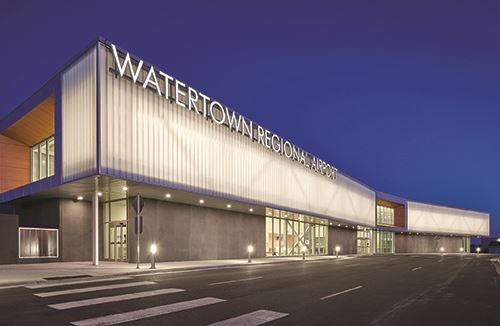Watertown Regional Airport (ATY) in South Dakota is an important travel gateway for the small city’s 22,000-plus residents and surrounding neighbors. Without the hometown airport, passengers would have to drive about 90 minutes south to Sioux Falls Regional Airport (FSD) or four hours east to much-larger Minneapolis-St. Paul International Airport (MSP).
Watertown Regional Airport (ATY) in South Dakota is an important travel gateway for the small city’s 22,000-plus residents and surrounding neighbors. Without the hometown airport, passengers would have to drive about 90 minutes south to Sioux Falls Regional Airport (FSD) or four hours east to much-larger Minneapolis-St. Paul International Airport (MSP).
 Perched on a plateau, ATY has always been picturesque; but its 1950s terminal buildings were definitely showing their age. Airport leaders had long wanted to build a new terminal and began preliminary planning to do so a few years ago.
Perched on a plateau, ATY has always been picturesque; but its 1950s terminal buildings were definitely showing their age. Airport leaders had long wanted to build a new terminal and began preliminary planning to do so a few years ago.
Their work came to fruition in August 2022 with the opening of a new 26,000-square-foot terminal building. The changes are striking and much appreciated. Modern check-in counters in the bright, airy ticketing hall make passengers forget the old, dated versions. Holdrooms with large windows and high ceilings replaced smaller, worn-out spaces. And the TSA checkpoint was streamlined for faster service.
|
Project: New Terminal Location: Watertown (SD) Regional Airport Airport Owner/Operator: City of Watertown, SD Terminal Size: 2 stories; 26,000 sq. ft. Airside: 2 gates; heated, moveable boarding bridge Commercial Carrier: Denver Air Connection Project Cost: Approx. $26 million
Timeline: Design submitted 2018; FAA funding Design & Project Manager: Mead & Hunt Architect: CO-OP Architecture Civil Engineering: Helms & Associates Structural Engineer: Rise Structural Associates Mechanical & Electrical Engineering: Mettler Sichmeller Engineering Boarding Bridge: JBT Aerotech |
Airport Manager Rob Cyrus described the previous terminal as old and dark and small. The new terminal, he says, is far more than just a place to fly in and out of—it’s open, welcoming and practically buzzes with a sense of community.
Planning and Funding
Air service at ATY has grown steadily over the last decades. The airport logged 14,655 enplanements in 2022 and now has room to accommodate more. Cyrus hopes to increase enplanements to 20,000 over the next few years.
True to its name, Watertown is situated near an abundance of freshwater bodies, including Lake Kampeska and Pelican Lake. The Big Sioux River bisects the city, feeding the local economy with visitors in search of tranquil fishing spots.
The airport’s new terminal plays a big role in attracting more visitors to the region. The vision for expansion started more than five years ago, even before ATY hired Wisconsin-based firm Mead & Hunt to lead planning for the new terminal. The firm began in 2018 by preparing a concept and budget planning study to help secure FAA supplemental discretionary funding.
For design, Mead & Hunt called upon CO-OP Architecture in Sioux Falls, SD. Doing so stacked the project with people who had special connections to the area. Mitch Walker, Aviation Architecture leader for Mead & Hunt, was born in Watertown; and Jason Kann, his counterpart from CO-OP, grew up there.
Walker notes that the project team had to move quickly to help ATY secure funding. After receiving notice in December 2019 that the grant request had been approved, design and planning began in earnest, as the team needed to finalize project plans before Aug. 1, 2020, to meet funding requirements.
Then, COVID-19 shook the industry and world, sending plans and timelines topsy-turvy.
Old-Time Public Access
Mead & Hunt and CO-OP conducted weekly meetings with a design committee assembled by the city council and airport board. This process entailed designing by committee, so decisions had to be streamlined to stay on schedule to meet Supplemental Funding requirements. Layering an emerging pandemic on top of that added even more complexity. And it wasn’t a simple remodel, either. The terminal needed a complete replacement, and the airport would need to break new ground to do so.
 “The old terminal building had been expanded six different times, and usable airport space was only about 8,500 square feet,” Walker explains. “The checkpoint required passenger movement down hallways and corridors, and after 9/11, it was no longer efficient.”
“The old terminal building had been expanded six different times, and usable airport space was only about 8,500 square feet,” Walker explains. “The checkpoint required passenger movement down hallways and corridors, and after 9/11, it was no longer efficient.”
In total, the team designed a new 26,000-square-foot terminal with streamlined security, contemporary design, modern check-in and car rental counters, and improved amenities. The result was a testament to staying organized and making decisions quickly.
“I would honestly say that was one of the most efficient decision-making committees I’ve ever been on,” says Kann. “They did a very good job on the city side.”
 Assistant City Manager/Public Works Director Heath VonEye was instrumental in helping shepherd the project from early concept through design, and also navigating funding and financial implementation during construction. “We wanted to take [the airport] back to the old days, when people would bring a family member to the gate and see them off,” VonEye explains. “We wanted it to have more of a family-and-friends atmosphere. Air travel is a huge part of our world, and being able to welcome people back home or see them off is an important part of that.”
Assistant City Manager/Public Works Director Heath VonEye was instrumental in helping shepherd the project from early concept through design, and also navigating funding and financial implementation during construction. “We wanted to take [the airport] back to the old days, when people would bring a family member to the gate and see them off,” VonEye explains. “We wanted it to have more of a family-and-friends atmosphere. Air travel is a huge part of our world, and being able to welcome people back home or see them off is an important part of that.”
The design vision was to return to a time when people visited airports for the sheer joy of seeing aircraft take off into the sky. Of course, security regulations preclude guests from joining passengers at the gate. But huge glass windows on the main floor and mezzanine that look out into the apron bring back the feeling of a bygone travel era, even for non-ticketed passengers. The two-story layout allows for ample air circulation and easy views of the airfield and nearby scenic vistas. Another amenity that harkens to earlier times: free parking for customers.
Danger Von Dempsey’s Slicehouse, a concessionaire in the terminal lobby, features pizza, beer and appetizers. Secure doors in the kitchen allow the restaurant to serve visitors on the public side as well as passengers who have already cleared the TSA checkpoint.
 “Mitch [Walker] and some of the folks at Mead & Hunt along with some from the airport board talked quite a bit about pre-9/11, and how you could watch people land and come off the planes. That has kind of gone away,” Kann reflects. “There was an interesting opportunity with the size of this airport to make it more of a public event, and that became a core piece of the design. That’s a very unique thing in an airport.”
“Mitch [Walker] and some of the folks at Mead & Hunt along with some from the airport board talked quite a bit about pre-9/11, and how you could watch people land and come off the planes. That has kind of gone away,” Kann reflects. “There was an interesting opportunity with the size of this airport to make it more of a public event, and that became a core piece of the design. That’s a very unique thing in an airport.”
Unique and award-winning, in fact. Late last year, the design team won an Honor Award from the American Institute of Architects (AIA) South Dakota for its work at ATY.
The new terminal has the potential to operate two gates, but only one is currently in service. It is used by Denver Air Connection, a subsidiary of Key Lime Air that provides scheduled service several times per week from ATY to Denver International and Chicago O’Hare. Interline agreements with United and American Airlines provide connections to just about anywhere in the world.
Going forward, ATY hopes to attract more general aviation business, as there is now more room for such operations. The airport encourages private pilots to use the airfield with competitive hangar leases and a professional environment, notes VonEye
Lake Area Technical College continues to hold pilot and aircraft repair courses at ATY, and can now expand its program by leasing the old terminal.

Sense of Place
The new terminal was designed to match the region’s personality, which is rooted in the outdoors and local industry.
“The airport is a very big piece of the community,” Kann says. “Agriculture is a huge industry as well as manufacturing, which is very apparent as the airport is located inside an industrial park. Hunting and fishing are huge; out-of-state visitors drive in for pheasant hunting. It was important to accommodate and have a sense of that as well.”
Summers in the region are moderate, and the winters quite cold, with about 35 inches of annual snowfall. With that in mind, the airport added a new building to provide centralized housing for all of its snow removal equipment. A heated, moveable boarding bridge from JBT Aerotech is a welcome addition that is keeping passengers comfortable and happy.
VonEye has high praise for the team that brought all the pieces together.
“I’ve been here [working on the ATY project] for five and a half years,” he says. “I know that Mead and Hunt is a cornerstone firm in the industry when it comes to airports. They rose to the top with their experience; they have the knowledge we needed to pour into this airport, and we feel they accomplished our goals perfectly. I think we’re now an envy of others in the region.”


 facts&figures
facts&figures

